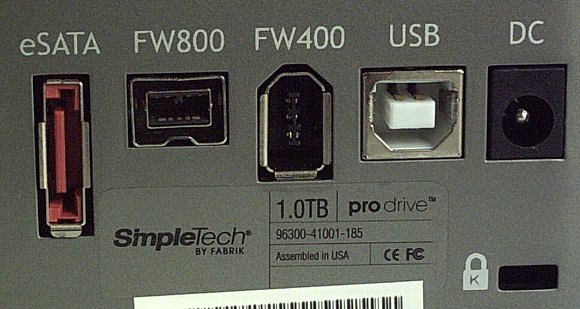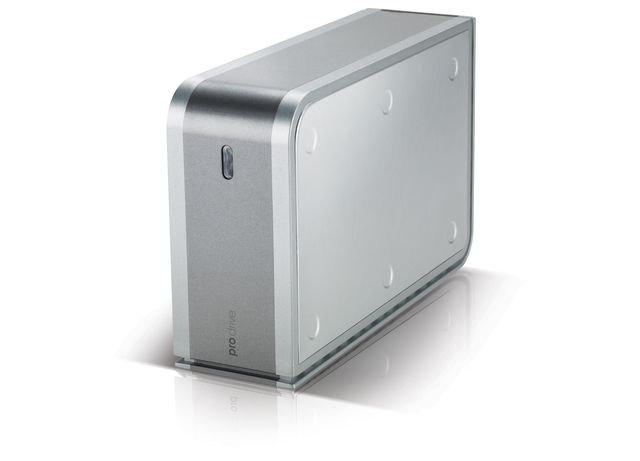‘Book Mystique Review: SimpleTech SimpleTech PRO1000Q Pro Drive Quad Interface 1TB External Hard Drive
Wednesday, December 3, 2008
by Charles W. Moore
I am a big fan of the external hard drive, I suppose dating back to the one that came with my very first Mac, a compact Mac Plus back in the early ‘90s. The Plus was designed to boot from an 800k floppy disk, but also supported external drives through its SCSI interface, and the original owner had added a whopping big 20 MB MacCrate drive by Seagate. It was loud, but a lot more convenient that swapping floppies, and SCSI is a fast I/O.
I dabbled a bit with Zip disks and a SCSI Zip Drive for a few years in the late ‘90s. You could boot the Classic Mac OS just fine from Zip Disk, but it wasn’t an especially robust or fast medium. By comparison, the QPS Que M2 FireWire hard drive that arrived here in 2001 was a revelation. It originally had a 6 gigabyte Fujitsu 2.5-inch laptop drive in it, and worked great with the MacAlly PC Cardbus FireWire adapter I had in my WallStreet PowerBook. FireWire throughput seemed as fast or faster than SCSI, but unlike SCSI it wasn’t finicky, and being a hot-pluggable, you didn’t have to shut down your system to mount or disconnect the drive.

I used that little QPS a lot over next several years. The original 6GB Fujitsu drive unit actually failed early on, but I replaced it first with a 10 gigabyte drive pulled from my WallStreet, and later on with the original 20 gigabyte Toshiba unit from my oldest Pismo. It’s served as a backup volume and and emergency/troubleshooting boot drive, although 20 gigabytes has being inadequate for global backups for some time now.
Enter a simpleTech SimpleDrive Pininfarina USB 2.0 external hard drive with twenty-five times the capacity (500 gigabytes) of that Pismo drive, and which has been my main backup volume for about two years now, segueing me nicely with into the OS X 10.5 Leopard Time Machine era. The Pininfarina SimpleDrive, styled by the same Italian design house that has done most Ferrari automobiles for the past fifty years or so, looks great, and has performed when likewise within the limitations of USB 2. It’s not much help with my older laptops that don’t support USB 2 (they will mount via USB 1.1 in a pinch, but that’s miserably slow for anything but very small file transfers). It’s also not bootable, but has been excellent as a Time Machine backup volume for my 17-inch PowerBook’s 80 GB drive.

Which brings us to the present, and the topic of this review, the SimpleDrive Pro Drive that comes in 500 gigabyte, 750 gigabyte, and one terabyte capacities. Our test unit was the 1 TB model.
They Pro Drive doesn’t have the Pininfarina drive’s Italianesque styling, but it’s attractive in a businesslike way, befitting a machine pitched as “professional - grade storage and backup,” and with its silver and grey two=tone plastic housing, which measures 7.8 x 5.5 x 2.5 inches, will harmonize as nicely with any Apple Computer.
This drive’s main distinction, however, is not its looks, but rather it’s quad I/0 interface, supporting USB 2.0, FireWire 400, FireWire 800, and 3GB/sec eIATA, which should have all your I/O bases covered whatever your computer hardware, including very high speed options where supported, but it will also work just fine for Time Machine backups via USB 2.0, if that’s all your system supports, for example, if you have a MacBook Air or one of the new unibody MacBooks.

Most Macs built over the past eight years have have FireWire 400, and many of the higher-end models support FireWire 800 as well (I even have a FireWire 800 PC Card adapter for my old 2000 Pismo PowerBooks), and FireWire is the no-hassle speedy choice for those machines. USB 2 is inferior to FireWire, but evidently the main I/o medium Apple has chosen for going forward, and USB 3, which will be backward compatible for connectivity, will hopefully address at least some of its deficiencies compared with FireWire.
As for the relative performance you can expect, USB 2.0 will give you real world throughput of up to 260 MB/sec, FireWire 400 up to 360 MB/sec, and FireWire 800 or eSATA can take you close to 800 MB/sec.
Fabrik bundles the Duo Pro with a data backup utility labeled Fabrik Local Backup, which is actually a Mac port of ArcSoft’s TotalMedia Backup and Record. I used this software for a time with the Pininfarina drive before Leopard and Time Machine landed, but wasn’t especially impressed with its features or performance, and I would anticipate that most Mac users purchasing this drive would opt for Time Machine or perhaps another good Mac backup application like CArbon Copy Cloner.
The SimpleTech Pro Drive is designed to be used upright, lying flat, or flat in stacks, is equipped with a security lock slot, works with Mac OS 10.3 or higher or Windows 2000/XP/Vista, and is covered by a three-year warranty. There is also free, unlimited tech support for the duration of the warranty.

The front of the Pro Drive Housing is simple, with just a product logo and a power-on/read/write activity light. On the back panel you will find a rocker power on/off switch, ventilation ports, the AC power adapter jack and a Kensington security lock slot, and the quad USB 2.0, FireWire 1394a, FireWire 1394 and eSATA ports.

The Pro Drive comes formatted in NFTS, which is a Windows oriented format that is read-only for Macs. In order to be able to write data to the drive, it will first have to be reformatted, the which of course destroys all the data on the drive.
The “Getting Started” guide that ships on the drive walks you through various formatting options if you need to get up to speed with that, so it’s best to download it to another volume before reformatting. The most useful format for Mac users will be Mac OS Extended, but if you want to be able to use the drive with both Macs and PCs you may want to use MS/DOS FAT 32 format, with but although that imposes some limitations, such as a 4 gigabyte file size limit. You will also have to use Windows file naming conventions.
If you want to be able to the boot from the drive, which is extremely convenient, you also need to pay attention to the the partition map protocol used for formatting. For booting Intel based Macs, you will want the GUID Partition Map, while the Apple Partition Map option is suitable for booting Power PC Macs. You can specify your chosen partition map option in the Options sheet of the OS X Disk Utility formatting pane.
Hooked up to my PowerBooks, I found the Pro Drive a tad slow to mount over the FireWire 400 interface, but it was fast copying files once it got up and running. FireWire 800 offers even faster throughput, and desktop users with PCI expansion slots can take advantage of Pro Drive’s claimed to be even faster SATA interface, which delivers up to 3X the speed of USB 2.0.

The Pro Drive comes with bundled USB and FireWire 400 cables, an AC power adapter, and 2 GB of free online Fabrik Ultimate Backup space (greater capacity can be had for fee), free unlimited tech support. FireWire 400 and/or eSATA connection cabling must be purchased separately.

The SimpleTech PRO1000Q ProDrive 1 TB has a suggested list price of $200.99, but is available at a street price, for example, of http://www.amazon.com/SimpleTech-PRO1000Q-Drive-Interface-External/dp/B001DH2E6M/ref=sr_1_1?ie=UTF8&s=electronics&qid=1228109080&sr=8-1 $149.98 at Amazon.com.
For more information, visit:
http://www.simpletech.com/products/storage/pro-drive
Note: Letters to PowerBook Mystique Mailbag may or may not be published at the editor's discretion. Correspondents' email addresses will NOT be published unless the correspondent specifically requests publication. Letters may be edited for length and/or context.
Opinions expressed in postings to PowerBook Mystique MailBag are owned by the respective correspondents and not necessarily shared or endorsed by the Editor and/or PowerBook Central management.
If you would prefer that your message not appear in PowerBook Mystique Mailbag, we would still like to hear from you. Just clearly mark your message "NOT FOR PUBLICATION," and it will not be published.
CM